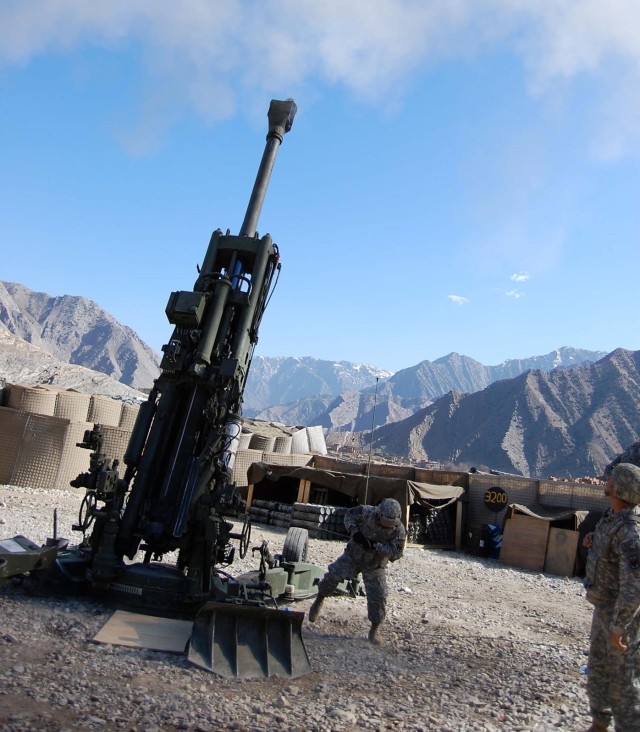From taking out top al-Qaida operatives to safely firing within 50 meters of dismounted infantrymen, the Picatinny Excalibur projectile is already paying dividends a year after its initial fielding to Soldiers.
When Excalibur first debuted in Iraq in May 2007, it became the Army's first all-weather, precision-guided artillery round.
While the Excalibur Program Office at Picatinny estimates approximately 70 of the ground-breaking Excalibur rounds have been fired in Iraq, Capt. Victor Scharstein of Alpha Battery, 2nd Battalion, 82nd Field Artillery, 3rd Brigade Combat Team, commanded one of the original units to field the round.
Scharstein used Excalibur multiple times in the Diyala province of Iraq. Operation Arrowhead Ripper, the deliberate clearance of Baquba, was one mission he recalls using the precision round.
"It was an urban setting, it was extremely bad weather and there were no aircraft able to fly that day," he said.
Because of Excalibur, his unit was able to fire an artillery round at a target within 50 meters of infantryman on the ground, who were clearing the area.
"Had we not had Excalibur, we wouldn't have been able to do that," he said. "We wouldn't have been able to engage that target."
While the unit could have engaged the target with conventional artillery, that would have risked significant collateral damage and put civilians and U.S. Soldiers at risk, Scharstein said.
Overall, Scharstein said the round was "amazingly accurate" with his fires producing a 92 percent success rate, meaning that the fired round hit or had an effect on the intended target 92 percent of the time.
The rest of the Army also began seeing the powerful effects of Excalibur almost immediately after its debut.
In July 2007 it was used to take down a top target for al-Qaida south of Baghdad, Iraq, according to a July 16, 2007 news release by Multi-National Division-Central Public Affairs.
This al-Qaida in Iraq cell leader was responsible for improvised explosive devices, vehicle-borne IEDs and indirect fire attacks on coalition forces in Arab Jabour.
The operative was in a meeting house when the 1st Battalion, 9th Field Artillery Regiment fired two Excalibur rounds and destroyed the house, the release said.
Such precision can be attributed to Excalibur's global-positioning system technology.
When the projectile leaves the gun, it does a self-test, acquires its signal and uses the signal to find its target, Scharstein said.
This precision accuracy has "brought artillery back into the close urban fight," Scharstein said. "Excalibur gives you the confidence that you can support Soldiers in the close fight."
"With conventional rounds, the first few rounds may not be on target so there has to be some adjusting," he added. "With Excalibur, as long as I have an accurate target location, I know I'm going to get an accurate hit every time."
"The accuracy of the system is unbelievable," he said. "It's incredibly accurate."
Excalibur Range
Another positive of Excalibur is its consistent ability to engage targets at a variety of ranges, Scharstein said.
Generally, the further away from a target you are, the less accurate the fires become, Scharstein said. However, with Excalibur, "you can shoot it at its minimum or maximum range and you'll get that same level of accuracy."
Excalibur, which debuted in Afghanistan in February 2008, currently has an accuracy of less than 10 meters at ranges out to 14 miles, said Lt. Col. Joseph Minus, Excalibur program manager at Picatinny Arsenal.
However, the next phase of Excalibur, called Ib, will have an accuracy requirement of less than 10 meters out to 24 miles, he said.
Not only do more accurate rounds reduce collateral damage and risk to dismounted Soldiers on the ground, but using less rounds limits the strain on the logistics train that provides the ammunition, Scharstein said.
Furthermore, he said Excalibur also gives brigade commanders an organic precision guided munition.
Previously, maneuver commanders would "use a direct-fire weapon system like a tank or a Bradley instead of bringing artillery in that close to infantry guys," Scharstein said.
Additionally, the Air Force and Navy could drop GPS munitions, but they're not organic to the Army - maneuver commanders still have to go through layers outside the Army to call for precision support, he said.
With Excalibur, all a battalion commander needs to do is turn around and tell the fire support officer 'I want precision-munitions on this target,' and it's available to them, Scharstein said.
This is more efficient since the commanders don't need find resources from outside the Army, he said.
Firing Excalibur
Excalibur can be fired from M109A6 Paladins and M777A2 Howitzers. The Excalibur program is also a cooperative program with the Kingdom of Sweden, which is developing the Archer Cannon System that will also be capable of providing precision fires with Excalibur, according to Minus.
Scharstein fired his Excalibur rounds from a Paladin and said firing Excalibur was similar if not easier than firing conventional artillery.
Because Excalibur is accurate, he said, operators do not need to frequently adjust fire to hit a target.
Excalibur also has a multi-functional fuze, which allows the round to be programmed to explode in the air, once it hits a hard surface or after it penetrates inside a target.
Conventional weapons have this same capability, but a fuze needs to be changed depending on which option is required, said Scharstein. With Excalibur's multi-functional fuze, instead of changing fuzes, you program the setting you want.
"It's very upfront...I didn't find it very difficult and I never heard any complaints from my Soldiers ...they loved the round and they loved firing it," Scharstein said.


Social Sharing